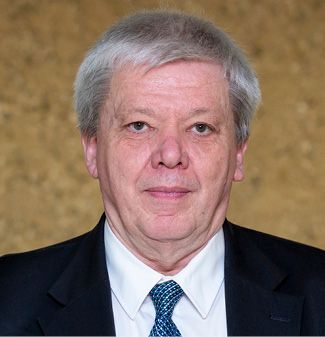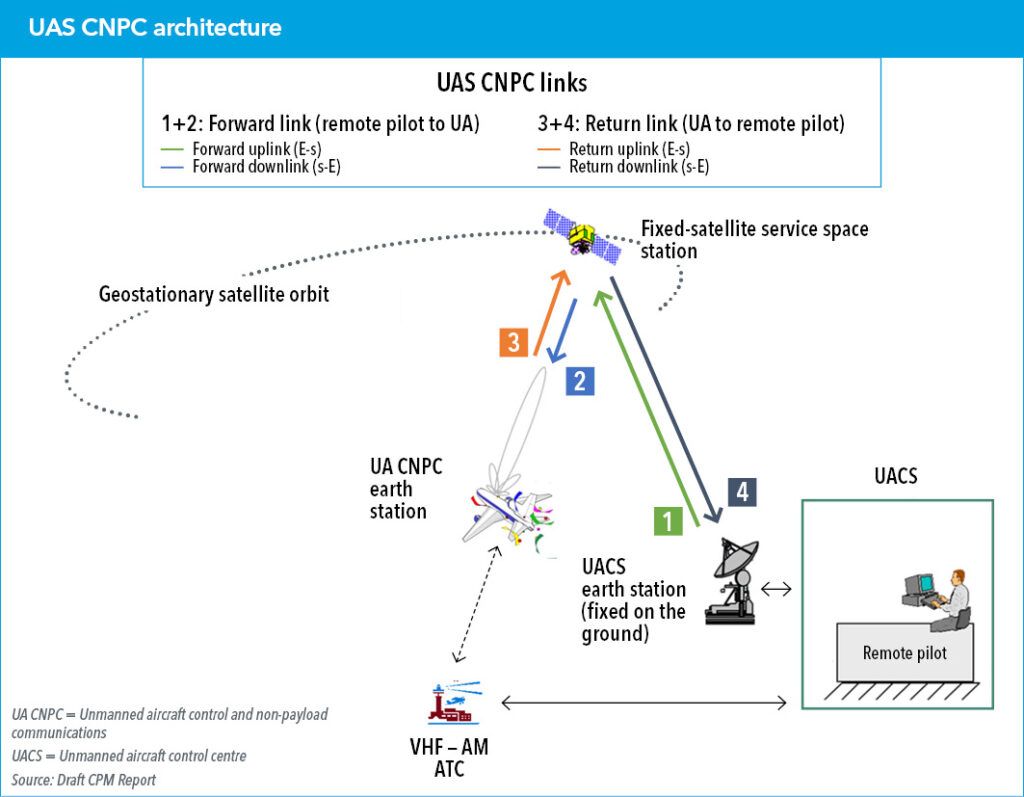
Controlling unmanned aircraft through links on regular communication satellites — a good or bad idea?


Per Hovstad, Principal Spectrum Engineer, AsiaSat
With interest in unmanned aircraft increasing, foreseen innovations include cargo planes, crop dusters, surveillance planes, and other uses. Like any other airplane, the flight of such planes needs to be controlled in a safe and reliable manner.
For long-haul flights over areas with low traffic density and over oceans, building a terrestrial radiocommunication network would be unrealistic, making the use of satellite links a logical choice. The figure below illustrates the architecture of an Unmanned Aircraft System for Control and Non‑Payload Communications (UAS CNPC).

Spectrum requirements for such use has been debated for decades and the 2012 World Radiocommunication Conference (WRC‑12), in response to the issue raised by WRC‑07, allocated spectrum in the 5000–5150-megahertz (MHz) band for the AMS(R)S — an aeronautical mobile-satellite service reserved for communications relating to the safety and regularity of flights, primarily along national or international civil air routes.
However, the 5000–5150 MHz band, being identified as a safety band, is not included in payloads –carried by regular communication satellites. Dedicated payloads for this purpose thus would need to be built, resulting in expensive solutions that would only be offered through a limited number of satellites.
A cheaper and simpler solution would be to use the regular, readily available transponders of commercial fixed satellite service (FSS) satellites.
Concerns about flight safety
In response to this issue raised by WRC‑12, WRC‑15 decided that UAS CNPC links operating in non-segregated airspace could be offered on the transponders of commercial FSS geostationary (GSO) satellites in the “unplanned” portions of Ku‑band, as well as “non-shared” (or allocated almost exclusively to FSS) Ka‑band.
However, WRC‑15 was unable to determine how flight safety could be ensured in a band shared with a multitude of commercial and governmental terrestrial and satellite uses, or how this could be done without having an undue impact on those uses.
Consequently, the upcoming WRC‑23 was tasked to review possible detailed regulatory and technical conditions for UAS CNPC operation.
And that’s where we are.
Being able to make use of transponders on regular GSO FSS satellites would, without doubt, be cheaper than building dedicated payloads for satellite links to control unmanned aircraft. It would also mean that many satellites could potentially support this application. Moreover, large and growing numbers of available satellites would provide better opportunities to build redundancy schemes to enhance flight safety.
In the work of the International Telecommunication Union (ITU) leading up to WRC‑23, there has been agreement that any recognition of the UAS CNPC application should not adversely impact other users sharing the same frequency bands. Nor should links for this application obtain a higher status than the regular non-safety FSS under which they operate.
Thus, UAS CNPC operation shall neither adversely affect future FSS networks during regular satellite coordination processes nor impose any additional coordination requirements.
Safety of life or other special requirements shall not be used as an argument to request more protection than what is normally considered during the regular bilateral coordination process between FSS networks. Furthermore, UAS CNPC operators must adequately protect terrestrial services and need to accept any interference caused by terrestrial services operating in conformity with the Radio Regulations.
Questions arising
When considering regulatory provisions and international recognition for widespread UAS CNPC use in regular FSS frequency bands, some important questions arise:
- Interference, normally accidental and unintended, is a regular occurrence between GSO networks in heavily used and severely congested commercial FSS bands. Furthermore, given the current increasing number of non-GSO FSS satellites being launched, operating in the same frequency bands and which do not coordinate with GSO satellites, are those frequency bands suitable to safely control the flight of unmanned aircraft? Are there ways to counter or mitigate interference in a satisfactory manner, such as redundant links or pre-programmed flight paths?
- Can UAS CNPC unconditionally accept interference from terrestrial services in the same frequency bands while ensuring the operational quality of service to safely control unmanned aircraft flight? If so, how?
- How can flight safety be assured without giving a higher status to UAS CNPC links than regular FSS links, and without having an adverse impact on those links? If higher levels of protection were required than those normally considered in bilateral discussions for regular FSS coordination, could this not constitute an obstacle for the coordination and introduction of future FSS networks?
- While spectrum use for UAS CNPC links lies within ITU’s remit, the responsibility for flight safety lies with the International Civil Aviation Organization (ICAO) which, independently of ITU, would need to develop its own regulations for UAS CNPC operation. Can we be sure that ICAO rules and regulations will not negate or contradict ITU rules and regulations, or go against principles agreed within ITU?
These are among the many and complex questions that administrations will need to consider under WRC‑23 agenda item 1.8 on the issue of the use of regular FSS transponders for UAS CNPC links. Ultimately, the delegates must determine whether the use by UAS CNPC links regular GSO FSS satellite transponders was really a good or a bad idea.
Download your copy of the ITU News Magazine: Land, sea and airwaves.
Header image credit: iStock
